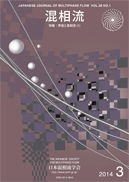Volume 28, Issue 1
Displaying 1-11 of 11 articles from this issue
- |<
- <
- 1
- >
- >|
Special Issue: Interface and Multiphase Flow (1)
-
2014Volume 28Issue 1 Pages 4-11
Published: March 15, 2014
Released on J-STAGE: May 20, 2014
Download PDF (2167K) -
2014Volume 28Issue 1 Pages 12-18
Published: March 15, 2014
Released on J-STAGE: May 20, 2014
Download PDF (1807K) -
2014Volume 28Issue 1 Pages 19-31
Published: March 15, 2014
Released on J-STAGE: May 20, 2014
Download PDF (2038K) -
2014Volume 28Issue 1 Pages 32-38
Published: March 15, 2014
Released on J-STAGE: May 20, 2014
Download PDF (1541K) -
2014Volume 28Issue 1 Pages 39-46
Published: March 15, 2014
Released on J-STAGE: May 20, 2014
Download PDF (1996K)
Review:
-
2014Volume 28Issue 1 Pages 47-54
Published: March 15, 2014
Released on J-STAGE: May 20, 2014
Download PDF (2478K)
Papers:
-
2014Volume 28Issue 1 Pages 55-61
Published: March 15, 2014
Released on J-STAGE: May 20, 2014
Download PDF (1279K) -
2014Volume 28Issue 1 Pages 62-70
Published: March 15, 2014
Released on J-STAGE: May 20, 2014
Download PDF (1614K) -
2014Volume 28Issue 1 Pages 71-80
Published: March 15, 2014
Released on J-STAGE: May 20, 2014
Download PDF (1431K) -
2014Volume 28Issue 1 Pages 81-89
Published: March 15, 2014
Released on J-STAGE: May 20, 2014
Download PDF (1367K) -
2014Volume 28Issue 1 Pages 90-98
Published: March 15, 2014
Released on J-STAGE: May 20, 2014
Download PDF (1350K)
- |<
- <
- 1
- >
- >|
